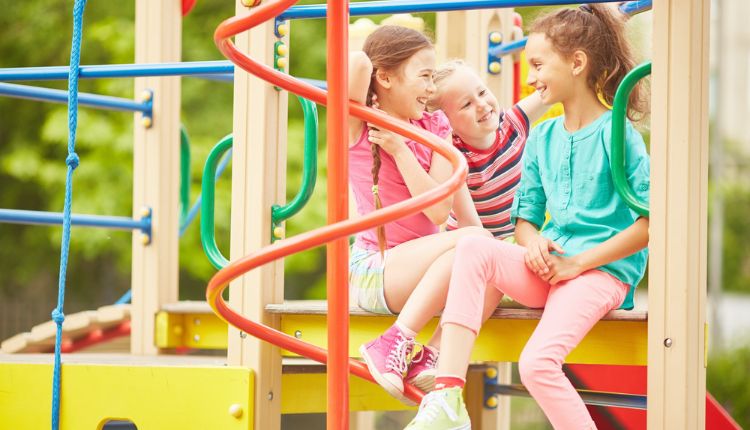Playgrounds are fun places for kids to be physically active, make friends and socialize. Unfortunately, playgrounds are also common sites for injuries — and many of these injuries are preventable. The most serious playground injuries involve falls from equipment. Providing appropriate impact attenuating surfacing beneath and around all equipment helps prevent these injuries.
Surface
The surface of a playground is important because more than 70 percent of injuries on playground equipment occur when kids fall to the ground. The surface must provide good impact attenuation and meet or exceed critical fall height standards set by international safety organizations such as IPEMA. The best playground surfaces are rubber, engineered wood fiber (EWF) and synthetic turf with protective under-padding. While these surfacing options may be more expensive than loose-fill coverings, they offer lower maintenance costs in the long run and can guarantee accessibility and ease of movement for children with wheelchairs.
The newest option is recycled rubber mulch, a nonporous material made from shredded tires that is held together by a binder and resists decomposition, blowing, fungal issues and other environmental factors. It meets ADA requirements and provides excellent impact attenuation and is very durable. It is also budget-friendly compared to poured rubber, which has a higher up-front cost but requires less maintenance over time.
Equipment
Playground equipment should be free of sharp points and edges that can cut or trap children. Equipment that can be climbed on should have proper guardrails and other safety measures in place. Falling to the ground causes more than 70 percent of playground injuries. Surfaces under and around equipment should be soft and durable, and should be made of wood fiber rubber mulch or a synthetic, bug-free material such as mats, poured surfaces or a combination of these materials.
Zones for different activities should be separated to avoid overcrowding, and pathways should allow easy travel between areas. Proper spacing between pieces of equipment also helps reduce injury risk, as does avoiding equipment that can be used by children who are not in the recommended age range. In addition, the surfacing should meet accessibility standards set by the U.S. Access Board, which is concerned with ensuring Americans with disabilities have equal access to public spaces.
Supervision
Maintaining constant supervision is the best way to keep kids 안전놀이터 . However, distractions are inevitable, and even the most well-meaning students or parents will take their attention from a child at some point during playtime. That’s why it’s important to create a supervision plan that allows for more than one adult to be present during playground use. This ensures that if a child is injured or another situation requires the supervisor’s attention, the other children will not go unsupervised.
To help with this, it’s also a good idea to analyze the playground and look for any areas that might be difficult to supervise from one spot. This might include obstructive elements such as trees or pieces of equipment that block the view. This can be a great opportunity to establish surveillance zones where an adult can monitor a specific area of the playground at a time.
Age-Appropriate
Children come in all sizes and levels of physical abilities. Equipment that is appropriate for older kids may be too big for toddlers or pre-schoolers, and equipment for children ages 6 months through 23 months should require supervision and safety surfacing specific to that age group. Young children’s gross motor skills aren’t developed enough to use many playground structures, especially those requiring upper body strength and agility. They also need softer surfaces, such as wood mulch or chips, shredded tires, sand or synthetic turf to protect against injuries caused by falls.
Close supervision is the best way to prevent most playground injuries. It requires adults to watch for hazards, observe children’s play, intercede and facilitate play when necessary and be available in case an injury occurs. In addition, adults should steer kids to age-appropriate equipment. And periodically inspect the playground for obvious problems, such as broken equipment or unsafe surfacing. Report them to the proper authorities immediately.
What’s Next?
Playgrounds offer kids exercise and the chance for unstructured, free play that’s important to their brain and physical development. However, most playground injuries occur when children fall from equipment. Make sure equipment is age-appropriate. Look for a safe surface that absorbs impact, such as wood chips, mulch, sand or shredded rubber (rather than concrete or asphalt). Avoid extra tripping hazards.
